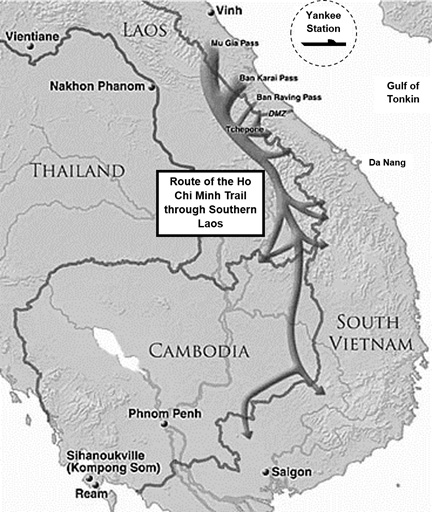History of the Ho Chi Minh Trail
The defeat of French forces at Dien Bien Phu in May of 1954 ended more than a century of colonialism in what was to become Vietnam. Shortly thereafter, the country formerly known as French Indochina was divided in two by the Geneva Convention. Communist North and Imperial South regions were split at the Ben Hai River near the 17th Parallel by a heavily patrolled Demilitarized Zone (DMZ).
Almost immediately following the separation, Communist leaders in North Vietnam, notably the Viet Minh hero Ho Chi Minh and party strong man Le Duan, renewed their efforts to achieve their long-held objective of an independent and reunified Vietnam under Communist rule. By the late 1950s it became obvious that success would depend upon their ability to sustain a steady flow of men and material from the ports and industrial centers of the North to the scenes of fighting in the South.
In May of 1959 two new military transportation units were formed under the Peoples’ Army of Vietnam (PAVN). Group 559 was charged with construction and maintenance of land supply lines, while Group 579 was responsible for waterborne shipments to the South. The turbulent political situation in Laos provided the opportunity for North Vietnam to invade their neighbor’s territory west of the Annamite Range, allowing Group 559 free access to the land they needed.
The overland course was designated Duong Truong Son—the Annamite Mountain Strategic Supply Route, named for the highland range separating Vietnam from Laos. Group 559 started with a modest force of about four hundred men and women, but soon grew exponentially as they improved and extended the existing primitive trails and roads of Eastern Laos.
By the mid-1960s, when the United States began to take serious action to stem the flood of men and supplies, the commander of the 559th, General Dong Si Nguyen, oversaw a force of more than twenty-four thousand men and women. His force was organized into eight engineer battalions for maintenance and nine transportation battalions that moved supplies via bicycle, trucks, and boats.
Within the next few years, as US air power focused on interdicting the flow of soldiers and supplies along the system, the labor force of Group 559 had grown to more than one hundred thousand soldiers and civilians.
At the same time, ships and smaller craft from both the US and South Vietnamese Navies, and even the US Coast Guard, initiated Operation Market Time to address the flow of military contraband by sea. When the operation got underway in mid-1965, it was estimated that 75% of the supplies moving to the South were transported by boat along the coastline. Relatively quickly the sea lines were nearly completely cut off, forcing the North Vietnamese to rely on their overland supply routes through Laos. By the late 1960s less than 10% of all materiel coming south was making it through by sea. The rest came by way of the network of roads and trails that became known as the Ho Chi Minh Trail.
North Vietnam’s blatant and continuing violation of neutral Laotian territory was not met with decisive action on the part of the United States and its allies in the tenuous Southeast Asia Treat Organization (SEATO).
